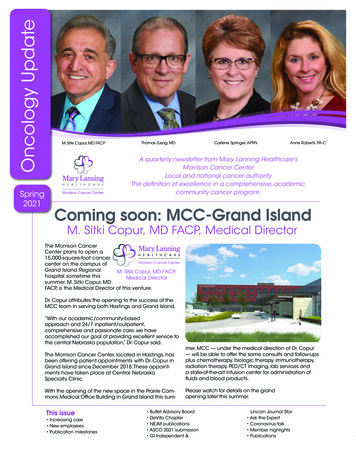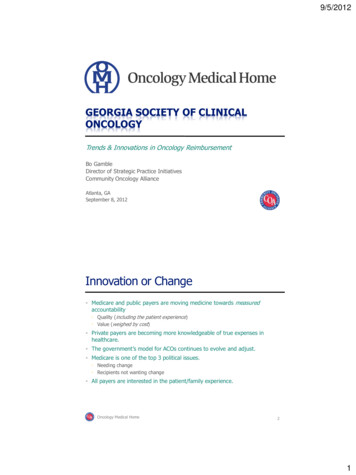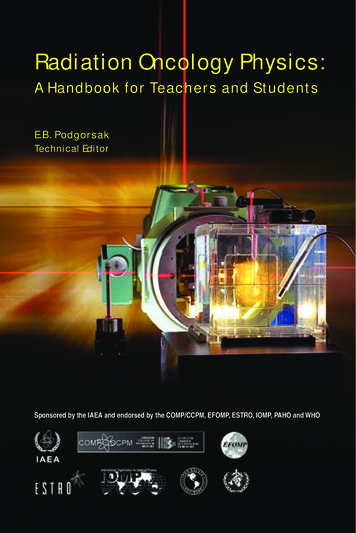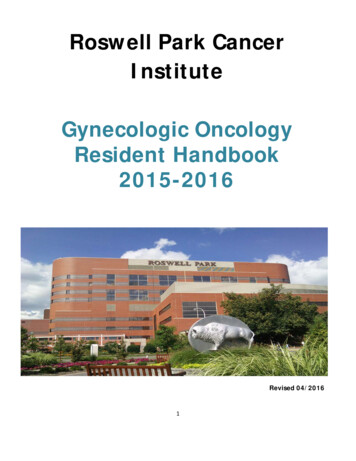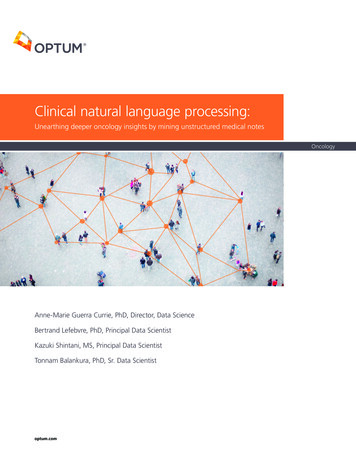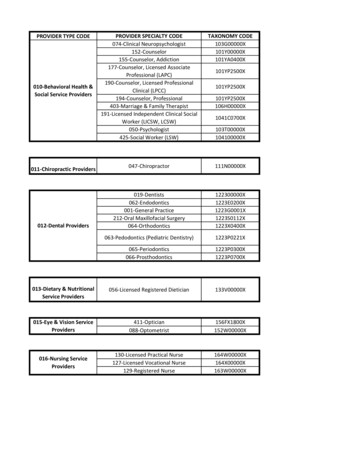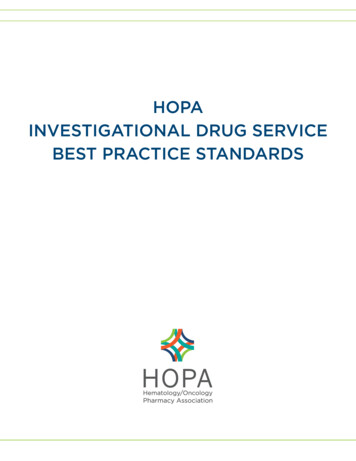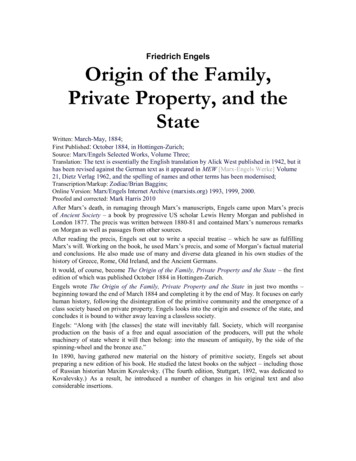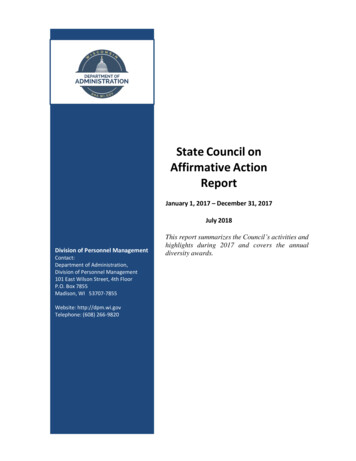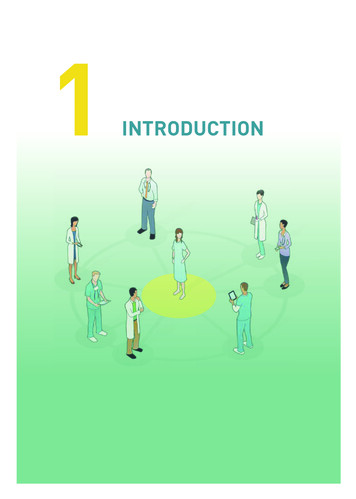
Transcription
1INTRODUCTION
1.1WHY DID WE WRITE THIS BOOK?The field of oncology and lymphology is constantly expanding in knowledge. Accordingly, evidence on the physiotherapeutic modalities used is evolving as well: during or after the treatment of cancer; in oncological rehabilitation; in the treatment of chronic edema and breast edema; in the management of surgical scars.However, there is a gap between the evidence from scientific studies and the implementation of these new insights and evidence in clinical practice, often because of areluctance to let go of old beliefs. Therefore, this book was written to inform the readerof the current evidence from a physiotherapeutic point of view and to provide insightinto how to integrate current evidence into daily clinical practice.1.2WHAT WILL THIS BOOK BE ABOUT?This textbook combines scientific evidence and clinical knowledge concerning physical therapies during or after oncological treatments, edema therapy and the therapiesused to treat surgical scars. There is a clear relationship between different parts of thistextbook. Many oncological treatments rely on surgery, which leaves surgical scars.Many patients suffer from fatigue, increased or decreased weight, loss of muscle massand muscle strength and decreased physical endurance or lymphedema after the treatment of cancer. Needless to say, these complications hamper Activity of Daily Living(ADL) activities and affect a patient’s quality of life.The aim of this textbook is to provide basic knowledge concerning oncological rehabilitation, the treatment of scars and burns and the treatment of chronic edema on behalfof improving patient-centred care.14ONCOLOGY, LYMPHOLOGY AND BEYOND
1.3FOR WHOM DID WE WRITE THIS BOOK?Although this textbook is written by a team of authors with a strong connection tophysiotherapy from both a scientific and clinical perspective, other health-care professionals will find the information in this textbook useful. Physicians will gain more insight into the conservative approaches to treating the side effects of oncological treatment, the treatment of chronic edema including breast edema and the managementof surgical scars before redoing surgery to treat a scar. The textbook will also familiarizephysicians with the different treatment modalities, as well as the evidence motivatingthe use of these modalities. As a result, physicians will be able to refer patients andprescribe physiotherapy more accurately. The information contained in this book willbe of help to patient-centred care in general.Today’s care for patients, especially for patients suffering from a chronic condition,needs to start from a patient-centred view. Therefore, the information in this textbookis highly relevant to those health-care professionals (e.g., nurses, dietician, psychologists, medical suppliers) who are involved in the care of oncological patients, patientswith chronic edema and patients with surgical scars. It provides them with information about the physiotherapeutic modalities and can discuss more accurately how andwhen other types of interventions should be implemented in the plan of care for certain patients. Our overall aim is to improve care for these types of patients.1.4THE EVIDENCE-BASED APPROACHThe information in this book was written based on carefully composed clinical questions using the PICOST methodology.1 These clinical questions were answered in linewith the scientific and clinical knowledge available at the moment of the writing of thistextbook. After obtaining this information, the evidence was translated into the clinicalreality of daily practice.To obtain the evidence, several systematic reviews were performed. Additional informationconcerning the systematic reviews can be found in the online platform Sofia. Apart fromthe systematic reviews that were executed by the teams of the different authors, information/evidence was appraised from other guidelines, systematic reviews and meta-analysisas well as original research; all based on the 6S approach as depicted in figure 1.1.You can find links to the International Lymphoedema Framework and the Journals atthe University of Arizona on the online learning platform Sofia.Introduction15
SystemsIntegra ng informa on from the lower levels of the hierarchy withindividual pa ent records, systems represent the ideal source of evidencefor clinical decision-making.SummariesSummaries are regularly updated clinical guidelines or textbooks thatintegrate evidence-based informa on about specific clinical problems.Synopses of synthesesSummarize the informa on found in systema c reviews. By drawingconclusions from evidence at lower levels of the pyramid, these synopseso en provide sufficient informa on to support clinical ac on.SynthesesCommonly referred to as a systema c review, a synthesis is a comprehensivesummary of all the evidence surrounding a specific research ques on(meta-analyses).Synopses of single studiesSummarize evidence from high-quality studies. The following evidence-basedabstract journals are the best place to find this type of informa on CATSingle studies with excellent methodologyUnique research conducted to answer specific clinical ques ons.Figure 1.1The 6S pyramid for pre-appraised evidence.2The clinical questions that formed the basis for retrieving the evidence used for thistextbook were: What are the side effects (both short-term and long-term) of an oncological treatment and how can a physical treatment provide relief for these side effects? What are the common aspects of an oncological rehabilitation? Do we need to take metabolism into account when setting up an oncological rehabilitation programme? What are common arm and shoulder complaints that warrant a physical treatmentduring or after the oncological treatment of breast cancer patients in particular? Can preventative action be taken to avoid chronic edema formation after oncologicaltreatments? What is the physical treatment of a chronic edema from a primary and secondaryaetiology? What is the treatment of choice for treating a chronic edema in the intensive phaseand maintenance phase? What is the current physiotherapeutic management of breast edema? What is the current physiotherapeutic management of surgical scars?16ONCOLOGY, LYMPHOLOGY AND BEYOND
1.5THE ICF MODEL AND PATIENT-CENTREDCAREThis textbook is written from a perspective that incorporates the International Classification of Functioning, Disability and Health (ICF)3 and patient-centred care.4Fortunately, for most people, functioning in daily life is something they take for granted.They can – within limits – do what they want. Yet in our care settings or in patient populations, there are people with physical and psychological problems that are so severethat they affect daily life or even make it impossible. Pain, associated with oncologic(or other) conditions, can cause sufferers to reduce their activity level significantly. Restrictions in mobility sometimes lead to not participating in sporting activities. Environmental factors, such as poor family support, colleagues who smoke or an unsuitableworkplace, can adversely affect the work situation.The ICF model (figure 1.2) was created by the World Health Organization in May 2001to create a common language for Functioning, Disability and Health.3You can find a link to the International Classification of Functioning, Disability andHealth on the online learning platform Sofia.The advantage of the ICF model is that it looks at health as a continuum and it appliesto everyone. The ICF as a biopsychosocial model addresses factors at both the individual and the social level. Additionally, the ICF model focuses on both positive andnegative aspects of health.3Health condi on(Disorder or disease)Body Func ons &StructuresAc vityPar cipa on(Impairments)(Limita ons)(Restric ons)Contextual factorsEnvironmental factorsFigure 1.2Personal factorsThe ICF framework as described by the WHO.3Introduction17
The ICF is a framework used around the world to describe a health condition of a patient in a broad biopsychosocial context. It applies to everyone, not just to people withfunctional problems. Everyone’s functional health condition can be described using theICF. It is now widely used, for instance to measure health status at the population level, in clinical and epidemiological settings to classify functional status assessment atthe individual level, and to identify goal settings, treatment planning and monitoringas well as outcome measurement. The ICF describes different domains of functioningfrom a body, individual and societal perspective. Its core structure consists of two parts: functioning and disability; contextual factors.1.5.1Functioning and disabilityWithin functioning and disability two subcategories are recognized: body functions and body structures; activities and participation.The body perspective is further divided into two components: The first is body functions and lists all physiological functions of body systems. The second, body structures, lists all anatomical parts of the body.The individual and societal perspectives are elaborated in the component activitiesand participation.1.5.2Contextual factorsBoth environmental and personal factors comprise the contextual factors category.The contextual factors (environmental or personal factors) may affect (facilitate or inhibit) all components of functioning and disability. Environmental factors include thephysical, social and attitudinal environment (e.g., profession, living environment, socialsupport) and personal factors refer to one’s attributes (e.g., age, gender, coping strategies) or internal influences on functioning.5 Definition of body functions: physiological and mental (psychological) properties/functions of the human organism/body systems. Definition of body structures: anatomical parts of the body such as organs,limbs and their components or position, presence, shape and continuity ofparts of the human body.18ONCOLOGY, LYMPHOLOGY AND BEYOND
Definition of activities: the execution of a task or action by an individual/components of an individual’s actions. Definition of participation: a person’s participation in society or involvementin a life situation. Definition of external factors: one’s physical and social environment in whichpeople live and conduct their life. Definition of personal factors: a person’s individual background.1.5.3Human (dys)functioningAn individual’s functioning consists of an interaction between the different componentsand ICF domains. There is a dynamic relationship between the ICF domains, and the interactions work in two directions, as illustrated in the figure. These components of human functioning and their problems can be represented in two ways. On the one hand,they can be used to indicate non-problematic aspects of human functioning, using theumbrella term human functioning. On the other hand, they can be used to describe disability and indicate problems, such as impairments in body function/structure, activitylimitations and participation restrictions, using the umbrella term disability.You can find a link to a practical manual on how to use the ICF on the online learningplatform Sofia. Definition of impairments: abnormalities in or loss of functions or anatomicalfeatures. Definition of limitations: difficulty a person has in performing daily activities. Definition of participation restrictions: problems a person experiences withparticipating in social life.Disability involves dysfunction at one or more of these levels: impairments in body function or structures, activity limitations and participation restrictions. Patients encountering devastating medical conditions may be confronted with long‐term impairments inbody structures (e.g., scars, edema) and body functioning (e.g., pain, limited mobility),activity limitations (e.g., inability to write) and participation restrictions (e.g., inabilityto go to school or work) during their rehabilitation. The interaction between all aspectsof functioning has a dynamic character: interventions on one aspect or factor can bringabout changes in other related aspects and factors. The interactions are specific anddo not have a predictable one-to-one relationship. As stated earlier, the interactionIntroduction19
takes place in both directions; the presence of functioning problems can influence adisorder or disease. It is important in the care process to collect data on these constructs independently and then to investigate possible relationships and causal links.For a complete description of (dys)functioning, all components are important. Externaland personal factors also influence a person’s state of health and level of functioning.They can each separately or together influence functioning problems at every level.The positive aspects and strengths within functioning can also be highlighted. The bio psychosocial vision of the ICF may make the very complex consequences of oncologicpathologies more comprehensible. The overall goal for every health-care practitioneris to recover the patients to the pre-injury state and to strive for an optimal functioningand reintegration into society with unaltered potential.1.6PATIENT-CENTRED CAREPatient or client-centred care (PCC) is defined by the Institute of Medicine as follows: “Providing care that is respectful of and responsive to individual patientpreferences, needs and values, and ensuring that patient values guide all clinicaldecisions”.In their often-cited literature review, Mead and Bower describe PCC as encompassingfive conceptual dimensions:6 the biopsychosocial perspective, i.e. beyond the disease state and including thepsychological and social domains; the ‘patient-as-person’; understanding an individual’s particular illness experience within his or her uniquelife context; sharing power and responsibility (an equal caregiver-patient relationship); the therapeutic alliance (care-giver-patient), with empathy, congruence and unconditional positive regard.If we implement patient-centred care within the caregiver process, the use of patient-reported outcome measures (PROMs) seems imperative. PROMs are the gold standardfor patient-centred care to efficiently evaluate the patient’s feelings, thoughts and complaints about a clinical intervention or disease. Clinicians use PROMs to guide and auditroutine care and support PCC. Many questionnaires are already part of standard intake20ONCOLOGY, LYMPHOLOGY AND BEYOND
procedures within oncologic rehabilitation. At the patient level, data can be used tomonitor individual progress, investigate the effects of medical and surgical interventionsand improve communication between patients and caregivers.7 Functional outcome isoften measured using PROMs. Expert consensus exists on using both generic and disease-specific Quality of Life (QoL) questionnaires to capture the full impact of a healthcondition.8The concept of Health Related Quality of Life (HRQOL) overlaps with that of healthand Quality of Life (QoL). Different definitions of these three concepts exist.9 In thismanuscript we make no explicit distinction between the different concepts and use theterm QoL as an all-encompassing term to talk about HRQOL and QoL measures for thereaders’ convenience.According to the WHOQOL group (1995), QoL is defined as: “An individual’s perceptions of their position in life in the context of the culture and value systemsin which they live and in relation to their goals, expectations, standards and concerns. It is a broad ranging concept affected in a complex way by the person’sphysical health, psychological state, level of independence, social relationshipsand their relationship to salient features of their environment.”10SharedpowerGoodexperienceInforma on exchangeEmpowermentWe encourage all health-care workers to approach patients in a holistic biopsychosocialway and in a patient-centred way. These are not empty concepts but require commitment, interaction and effort from all parties involved. At regular intervals in the careprocess, the following questions seem important to us: What is my patient’s wish? What is my patient’s idea, opinion or feeling? How has his or her biopsychosocial functioning changed? How can I empower the patient as part of the (multidisciplinary) team?SharedaccountabilityCollabora on JointdecisionmakingClearvoice Communica onSharedresponsibilityFigure 1.3Important aspects of patient-centred care.Introduction21
1.71.2.3.4.5.6.7.8.9.10.22REFERENCESGebruers N, Meeus M. Health Science Literacy. From research to review. Acco; 2021.DiCenso A, Bayley L, Haynes RB. ACP Journal Club. Editorial: Accessing preappraised evidence:fine-tuning the 5S model into a 6S model. Ann Intern Med. 2009;151(6):Jc3-2, jc3-3.World Health O. International classification of functioning, disability and health: ICF. In. Geneva:World Health Organization; 2001.Barry MJ, Edgman-Levitan S. Shared decision making--pinnacle of patient-centered care. N EnglJ Med. 2012;366(9):780-781.Peterson DB. International Classification of Functioning, Disability and Health: An Introductionfor Rehabilitation Psychologists. Rehabilitation psychology. 2005;50(2):105-112.Mead N, Bower P. Patient-centredness: a conceptual framework and review of the empiricalliterature. Soc Sci Med. 2000;51(7):1087-1110.Meirte J, Hellemans N, Anthonissen M, et al. Benefits and Disadvantages of Electronic Patient-reported Outcome Measures: Systematic Review. JMIR Perioper Med. 2020;3(1):e15588.Van Beeck EF, Larsen CF, Lyons RA, Meerding WJ, Mulder S, Essink-Bot ML. Guidelines for the conduction of follow-up studies measuring injury-related disability. J Trauma. 2007;62(2):534-550.Karimi M, Brazier J. Health, Health-Related Quality of Life, and Quality of Life: What is the Difference? Pharmacoeconomics. 2016;34(7):645-649.The World Health Organization Quality of Life assessment (WHOQOL): position paper from theWorld Health Organization. Soc Sci Med. 1995;41(10):1403-1409.ONCOlOgy, lympHOlOgy ANd bEyONd
This textbook combines scientificevidence and clinical knowledge concerning physi-cal therapies during or afteroncological treatments, edema therapy and the therapies used to treat surgical scars. There is a clear relationshipbetween differentparts of this textbook. Many oncological
